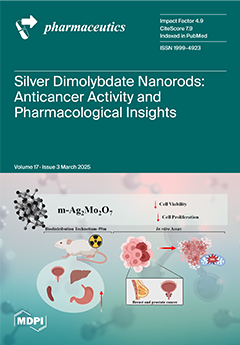Background: Curcumin has been proved to have promising prospects in the fields of anti-inflammation, antibacterial, anti-oxidation, and neuroprotection. However, its poor water solubility and stability in strong acid, as well as fast metabolism, lead to low bioavailability, making it difficult to develop
[...] Read more.
Background: Curcumin has been proved to have promising prospects in the fields of anti-inflammation, antibacterial, anti-oxidation, and neuroprotection. However, its poor water solubility and stability in strong acid, as well as fast metabolism, lead to low bioavailability, making it difficult to develop further. This study aimed to improve the bioavailability of curcumin by using microfluidic preparation technology.
Methods: Using a self-built microfluidic system, polyvinylpyrrolidone K30 and sodium dodecyl sulfate were used as stabilizers to further prepare curcumin–phospholipid complex nanoparticles (CPC-NPs) on the basis of curcumin–phospholipid complex (CPC). The CPC-NPs were characterized and evaluated by X-ray powder diffraction (XRD), differential scanning caborimetry (DSC), dynamic light scattering, and transmission electron microscopy (TEM). Blood samples were collected from rats after oral administration of curcumin, CPC, curcumin nanoparticles (CUR-NPs), and CPC-NPs, respectively. The pharmacokinetics were analyzed by enzymatic digestion and HPLC.
Results: The optimized CPC-NPs had a particle size of 71.19 ± 1.37 nm, a PDI of 0.226 ± 0.047, and a zeta potential of −38.23 ± 0.89 mV, which showed a spherical structure under TEM and good stability within 5 days at 4 °C and 25 °C. It was successfully characterized by XRD combined with DSC, indicating the integrational state of curcumin–soy lecithin and conversion to an amorphous form. The results of the pharmacokinetic study showed that the C
max of curcumin, CUR-NPs, CPC, and CPC-NPs were 133.60 ± 28.10, 270.23 ± 125.42, 1894.43 ± 672.65, and 2163.87 ± 777.36 ng/mL, respectively; the AUC
0–t of curcumin, CUR-NPs, CPC, and CPC-NPs were 936.99 ± 201.83, 1155.46 ± 340.38, 5888.79 ± 1073.32, and 9494.28 ± 1863.64 ng/mL/h.
Conclusions: CPC-NPs prepared by microfluidic technology had more controllable quality than that of traditional preparation and showed superior bioavailability compared with free drug, CPC, and CUR-NPs. Pharmacodynamic evaluation of anti-inflammatory, anti-oxidation, and neuroprotection needs to be confirmed in follow-up studies.
Full article






